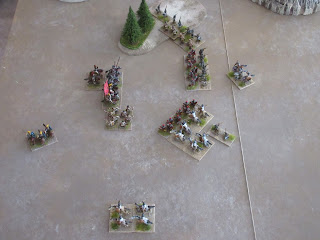Those readers who have followed the history of the
Roman Limes will know that North Africa held a peculiar status; it lacked a
formal defensive system of walls and forts. Since the Augustan period as the number of coloniae in North Africa increased, land estates became fortified strong points which served well enough to frustrate the raiders from the
Atlas Mountains. Here is one punitive expedition resulting in three battles.
II/64b Middle
Imperial Roman (Western)
1 x general (Cv), 1 x cavalry (Cv), 1 x horse archer
(LH), 4 x legionnaires (4Bd), 3 x auxiliary (4Ax), 1 x archers (4Bw), 1 x Cataphract (3Kn).
II/57
Later Moorish
1 x general (LH), 5 x light horse (LH), 6 x javelinmen
(3Ax or Ps).
Game one
Exiting the valley space the Romans could see a cloud
of skirmishing cavalry and foot were quickly approaching.
The legion quickly moved forward and would drive
through their ranks with auxilia supporting the effort on both
flanks.
The legionnaires in their excitement were quickly
leaving their supports behind. A unit of reserve cavalry was sent to support
the legionary left, but help would not arrive in time to help the right flank now
engulfed by hordes of Moorish foot troops. The situation was very tense as the
score evened up, 3 – 3.
Rome now delivered a well coordinated counter attack
catching a number of enemy off guard, some cut off from friends or had their
flight blocked were quickly cut to pieces. Score
6 – 3 for Rome.
Game two
Rome could see her right flank fully exposed to the
open waste land and to compensate the army deployed in a compact formation
almost inviting the Moors to lap around while Rome worked from a central
position.
That was the plan.
The Moors did send light horse to occupy the Roman
right, but took measures to first clear the wood of auxilia before committing
the entire army.
Encountering still resistance in the wood, Rome used
the moment to move her legions forward hoping to catch the enemy off balance.
This had the desired effect of shattering the Moorish
effort into disjointed attacks. Unfortunately, Rome had the better of the
opportunity. Score 4 – 1 for Rome.
Game
three
Rome caught the Moors at a disadvantageous moment as
her army was split by a series of hills. The legions would quickly move forward
while the cavalry followed in support.
Some time elapsed between signalling the various units
that a storm rising out from the desert was nearly missed. This sent Roman
units scrambling to form a line of troops on the left flank while the legionary
units held their advance in check.
The situation became so desperate the entire cavalry
reserve was committed to stave off the Moorish attack.
In less than 30 minutes (2 bounds) all was quiet again
as the dust trails or Moors were seen retreating. Score 6 - 2 for Rome.













No comments:
Post a Comment